2008 CHRYSLER TOWN AND COUNTRY child restraint
[x] Cancel search: child restraintPage 12 of 531
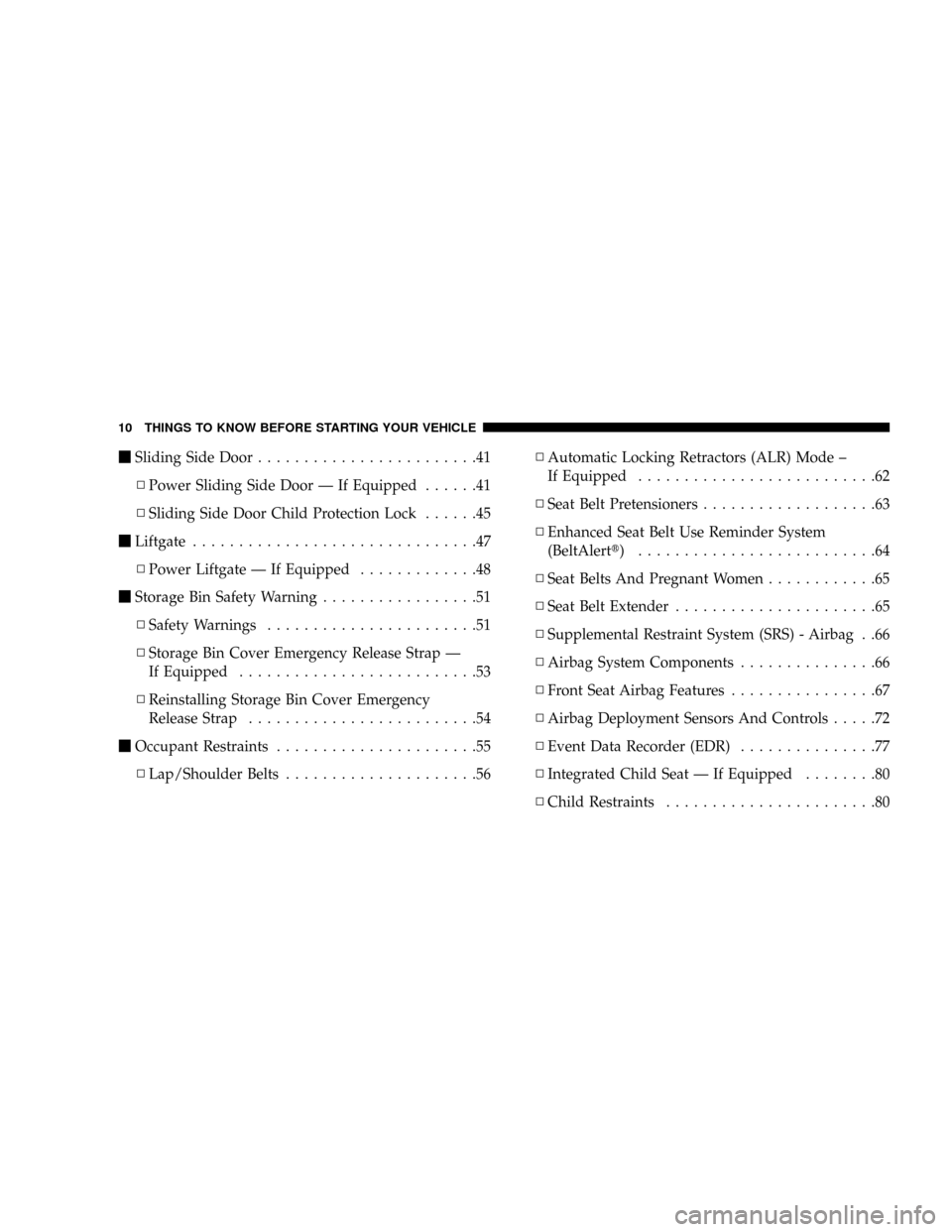
mSliding Side Door........................41
NPower Sliding Side Door Ð If Equipped......41
NSliding Side Door Child Protection Lock......45
mLiftgate...............................47
NPower Liftgate Ð If Equipped.............48
mStorage Bin Safety Warning.................51
NSafety Warnings.......................51
NStorage Bin Cover Emergency Release Strap Ð
If Equipped..........................53
NReinstalling Storage Bin Cover Emergency
Release Strap.........................54
mOccupant Restraints......................55
NLap/Shoulder Belts.....................56NAutomatic Locking Retractors (ALR) Mode ±
If Equipped..........................62
NSeat Belt Pretensioners...................63
NEnhanced Seat Belt Use Reminder System
(BeltAlertt) ..........................64
NSeat Belts And Pregnant Women............65
NSeat Belt Extender......................65
NSupplemental Restraint System (SRS) - Airbag . .66
NAirbag System Components...............66
NFront Seat Airbag Features................67
NAirbag Deployment Sensors And Controls.....72
NEvent Data Recorder (EDR)...............77
NIntegrated Child Seat Ð If Equipped........80
NChild Restraints.......................80
10 THINGS TO KNOW BEFORE STARTING YOUR VEHICLE
Page 57 of 531
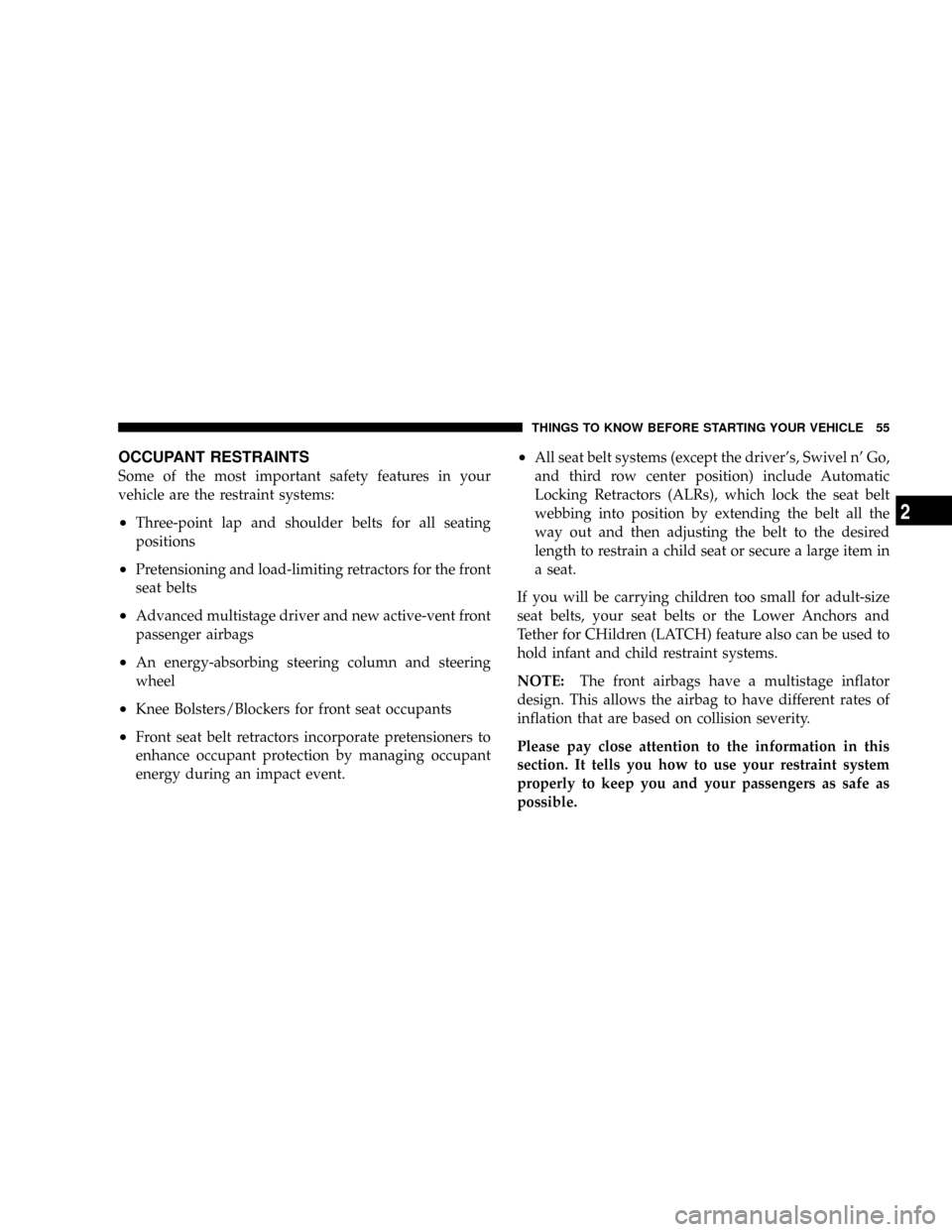
OCCUPANT RESTRAINTS
Some of the most important safety features in your
vehicle are the restraint systems:
²Three-point lap and shoulder belts for all seating
positions
²Pretensioning and load-limiting retractors for the front
seat belts
²Advanced multistage driver and new active-vent front
passenger airbags
²An energy-absorbing steering column and steering
wheel
²Knee Bolsters/Blockers for front seat occupants
²Front seat belt retractors incorporate pretensioners to
enhance occupant protection by managing occupant
energy during an impact event.
²All seat belt systems (except the driver's, Swivel n' Go,
and third row center position) include Automatic
Locking Retractors (ALRs), which lock the seat belt
webbing into position by extending the belt all the
way out and then adjusting the belt to the desired
length to restrain a child seat or secure a large item in
a seat.
If you will be carrying children too small for adult-size
seat belts, your seat belts or the Lower Anchors and
Tether for CHildren (LATCH) feature also can be used to
hold infant and child restraint systems.
NOTE:The front airbags have a multistage inflator
design. This allows the airbag to have different rates of
inflation that are based on collision severity.
Please pay close attention to the information in this
section. It tells you how to use your restraint system
properly to keep you and your passengers as safe as
possible.
THINGS TO KNOW BEFORE STARTING YOUR VEHICLE 55
2
Page 65 of 531
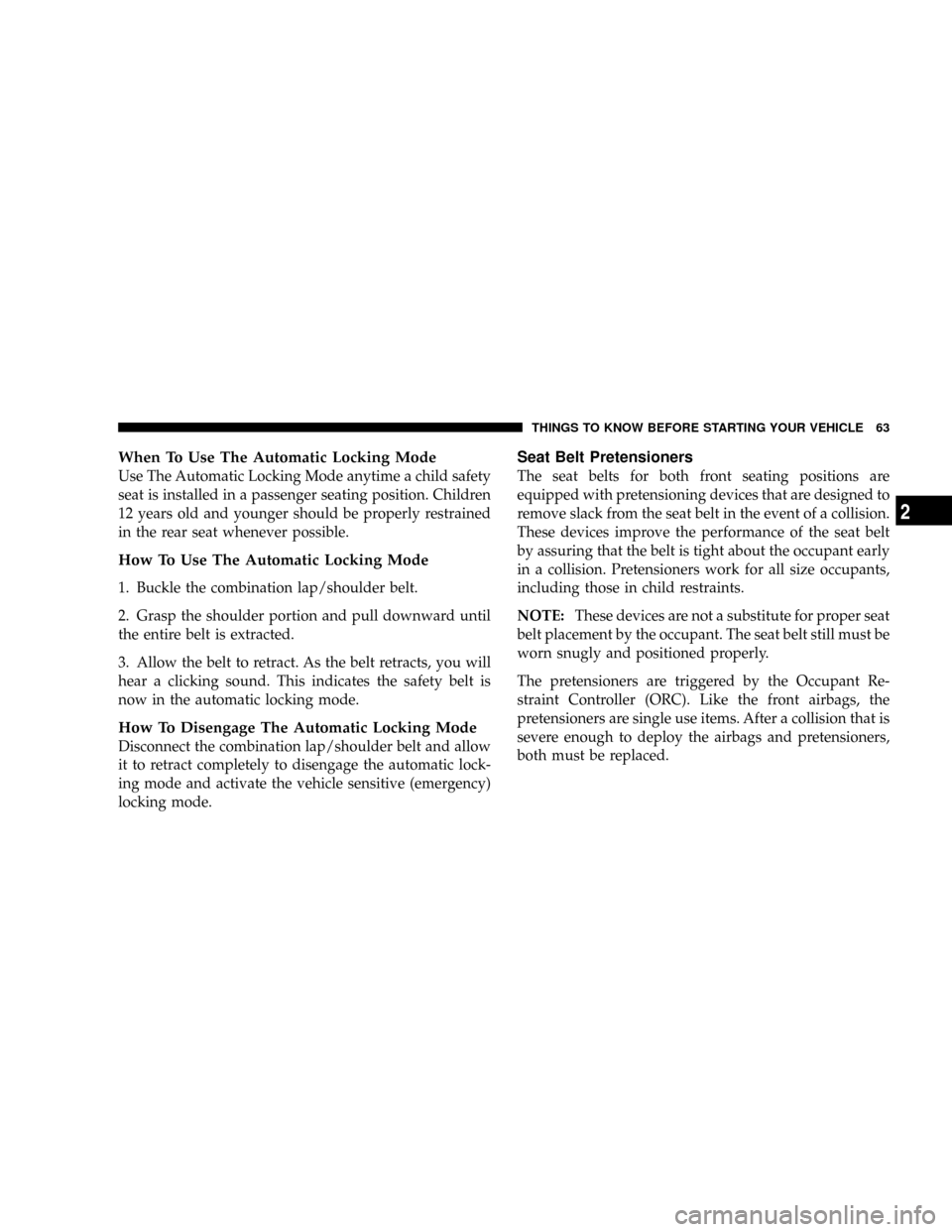
When To Use The Automatic Locking Mode
Use The Automatic Locking Mode anytime a child safety
seat is installed in a passenger seating position. Children
12 years old and younger should be properly restrained
in the rear seat whenever possible.
How To Use The Automatic Locking Mode
1. Buckle the combination lap/shoulder belt.
2. Grasp the shoulder portion and pull downward until
the entire belt is extracted.
3. Allow the belt to retract. As the belt retracts, you will
hear a clicking sound. This indicates the safety belt is
now in the automatic locking mode.
How To Disengage The Automatic Locking Mode
Disconnect the combination lap/shoulder belt and allow
it to retract completely to disengage the automatic lock-
ing mode and activate the vehicle sensitive (emergency)
locking mode.
Seat Belt Pretensioners
The seat belts for both front seating positions are
equipped with pretensioning devices that are designed to
remove slack from the seat belt in the event of a collision.
These devices improve the performance of the seat belt
by assuring that the belt is tight about the occupant early
in a collision. Pretensioners work for all size occupants,
including those in child restraints.
NOTE:These devices are not a substitute for proper seat
belt placement by the occupant. The seat belt still must be
worn snugly and positioned properly.
The pretensioners are triggered by the Occupant Re-
straint Controller (ORC). Like the front airbags, the
pretensioners are single use items. After a collision that is
severe enough to deploy the airbags and pretensioners,
both must be replaced.
THINGS TO KNOW BEFORE STARTING YOUR VEHICLE 63
2
Page 72 of 531
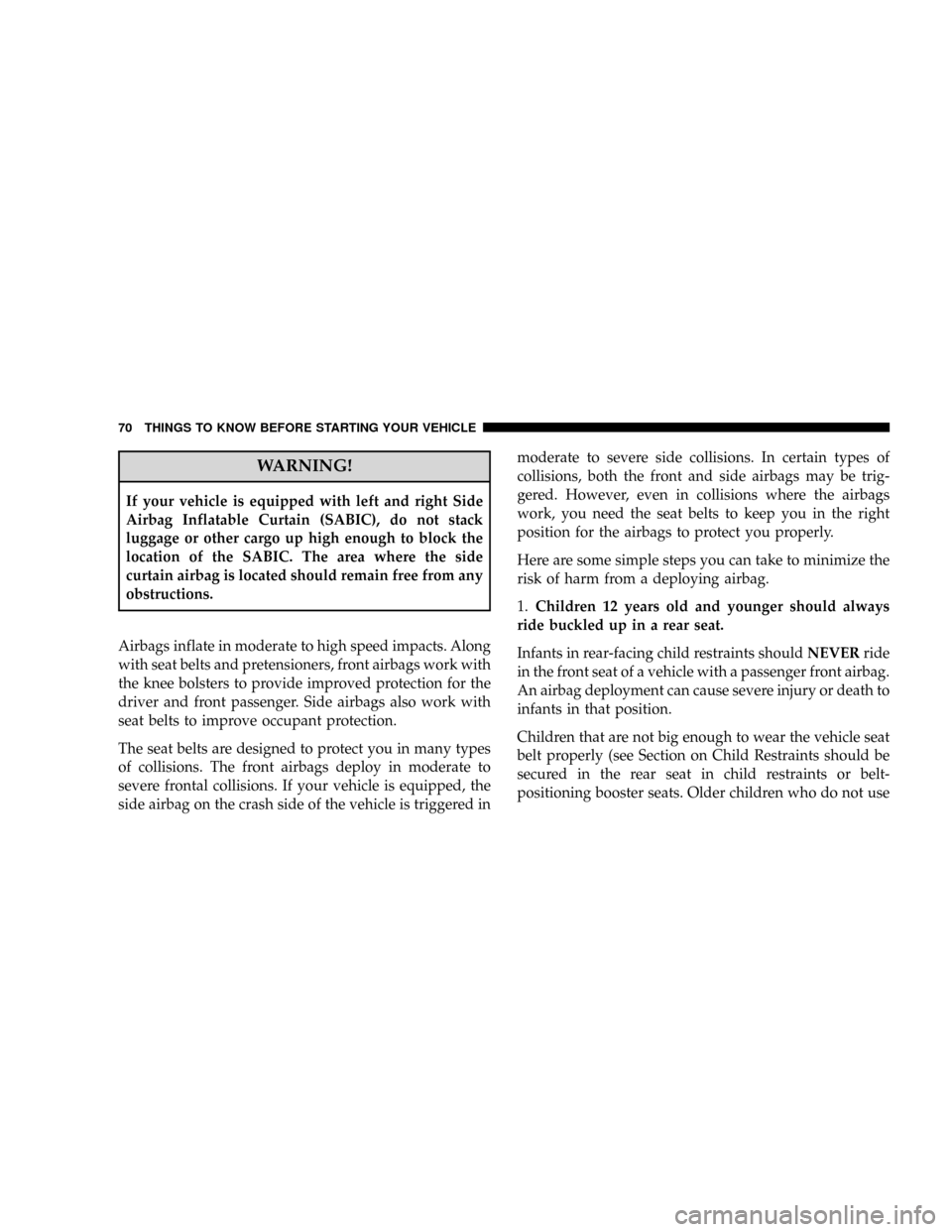
WARNING!
If your vehicle is equipped with left and right Side
Airbag Inflatable Curtain (SABIC), do not stack
luggage or other cargo up high enough to block the
location of the SABIC. The area where the side
curtain airbag is located should remain free from any
obstructions.
Airbags inflate in moderate to high speed impacts. Along
with seat belts and pretensioners, front airbags work with
the knee bolsters to provide improved protection for the
driver and front passenger. Side airbags also work with
seat belts to improve occupant protection.
The seat belts are designed to protect you in many types
of collisions. The front airbags deploy in moderate to
severe frontal collisions. If your vehicle is equipped, the
side airbag on the crash side of the vehicle is triggered inmoderate to severe side collisions. In certain types of
collisions, both the front and side airbags may be trig-
gered. However, even in collisions where the airbags
work, you need the seat belts to keep you in the right
position for the airbags to protect you properly.
Here are some simple steps you can take to minimize the
risk of harm from a deploying airbag.
1.Children 12 years old and younger should always
ride buckled up in a rear seat.
Infants in rear-facing child restraints shouldNEVERride
in the front seat of a vehicle with a passenger front airbag.
An airbag deployment can cause severe injury or death to
infants in that position.
Children that are not big enough to wear the vehicle seat
belt properly (see Section on Child Restraints should be
secured in the rear seat in child restraints or belt-
positioning booster seats. Older children who do not use
70 THINGS TO KNOW BEFORE STARTING YOUR VEHICLE
Page 73 of 531
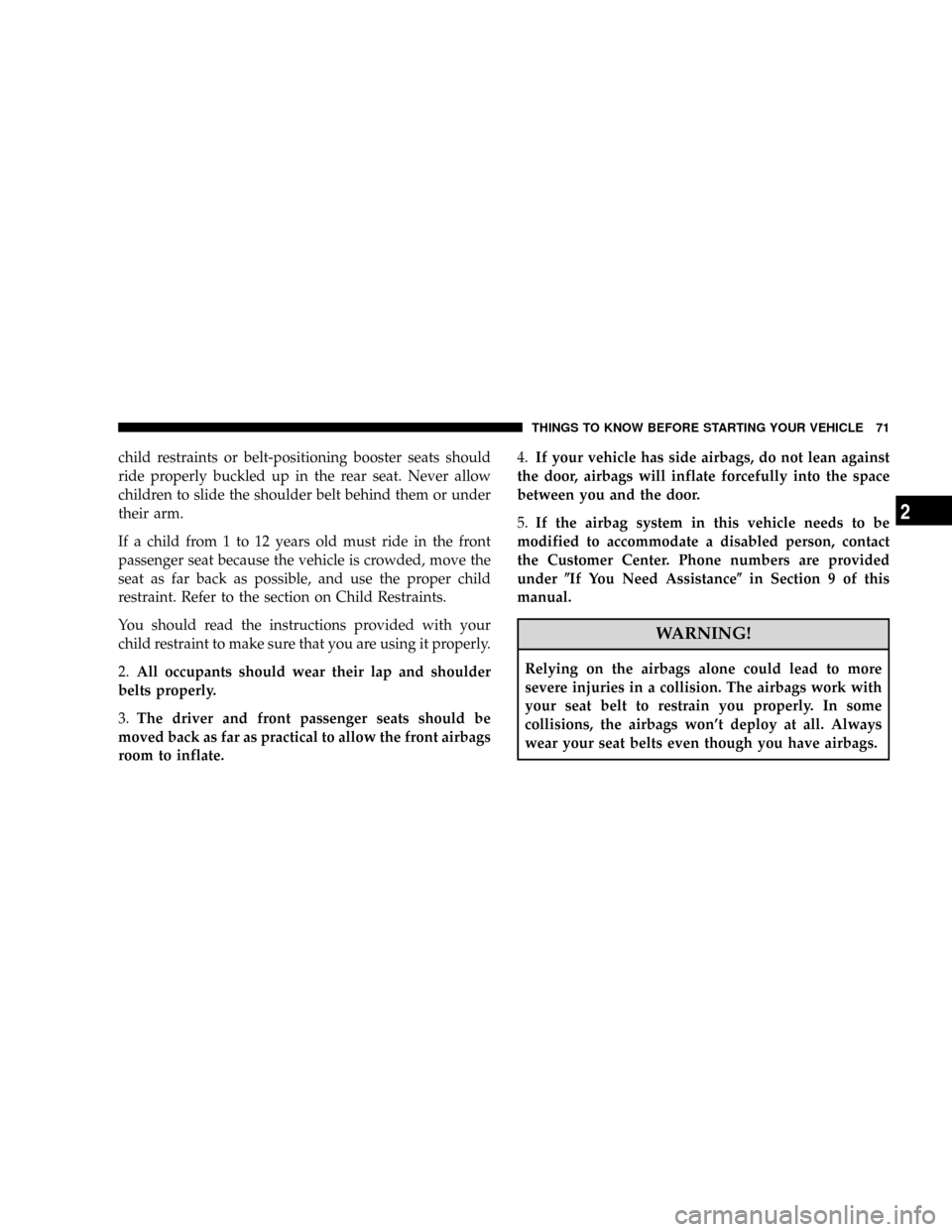
child restraints or belt-positioning booster seats should
ride properly buckled up in the rear seat. Never allow
children to slide the shoulder belt behind them or under
their arm.
If a child from 1 to 12 years old must ride in the front
passenger seat because the vehicle is crowded, move the
seat as far back as possible, and use the proper child
restraint. Refer to the section on Child Restraints.
You should read the instructions provided with your
child restraint to make sure that you are using it properly.
2.All occupants should wear their lap and shoulder
belts properly.
3.The driver and front passenger seats should be
moved back as far as practical to allow the front airbags
room to inflate.4.If your vehicle has side airbags, do not lean against
the door, airbags will inflate forcefully into the space
between you and the door.
5.If the airbag system in this vehicle needs to be
modified to accommodate a disabled person, contact
the Customer Center. Phone numbers are provided
under(If You Need Assistance(in Section 9 of this
manual.
WARNING!
Relying on the airbags alone could lead to more
severe injuries in a collision. The airbags work with
your seat belt to restrain you properly. In some
collisions, the airbags won't deploy at all. Always
wear your seat belts even though you have airbags.
THINGS TO KNOW BEFORE STARTING YOUR VEHICLE 71
2
Page 82 of 531
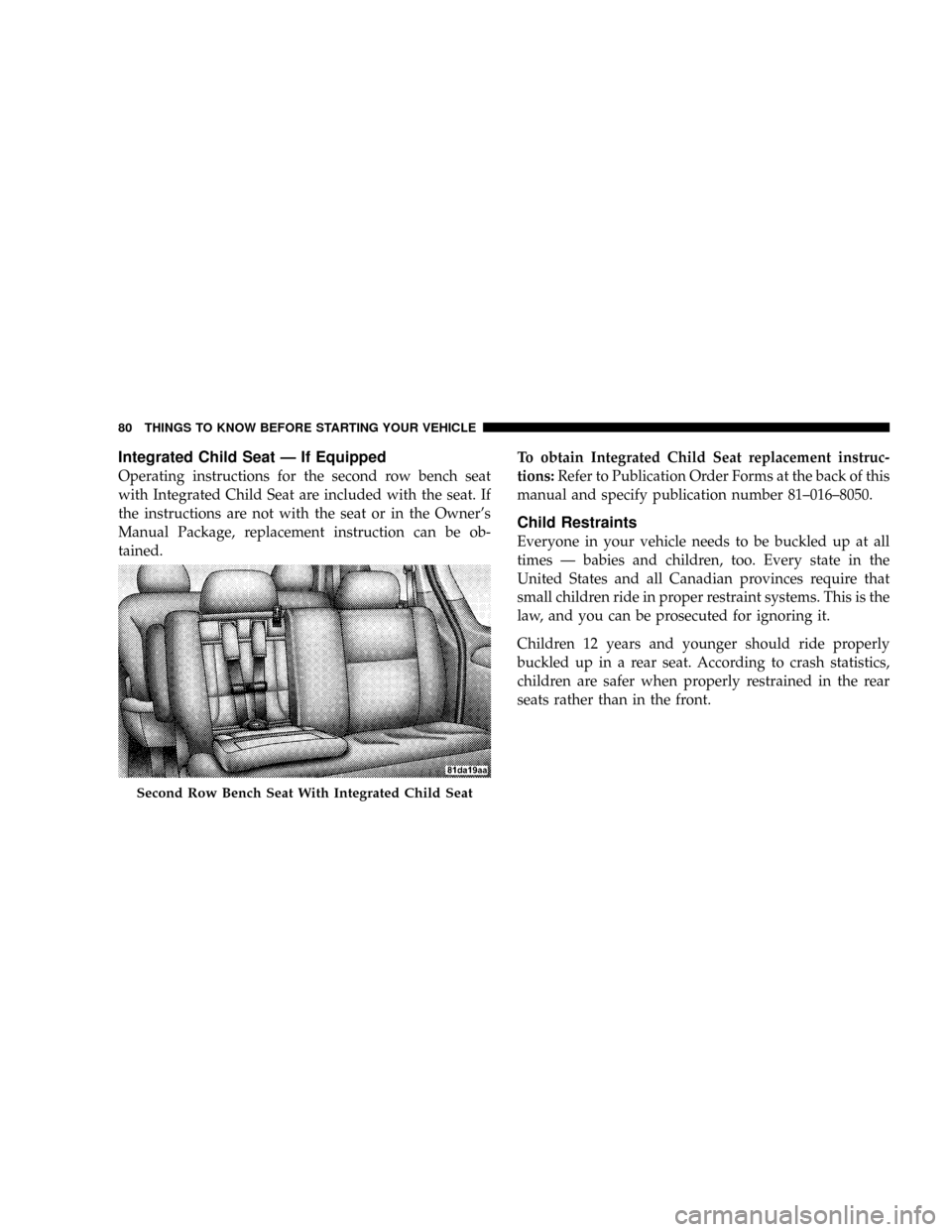
Integrated Child Seat Ð If Equipped
Operating instructions for the second row bench seat
with Integrated Child Seat are included with the seat. If
the instructions are not with the seat or in the Owner's
Manual Package, replacement instruction can be ob-
tained.To obtain Integrated Child Seat replacement instruc-
tions:Refer to Publication Order Forms at the back of this
manual and specify publication number 81±016±8050.
Child Restraints
Everyone in your vehicle needs to be buckled up at all
times Ð babies and children, too. Every state in the
United States and all Canadian provinces require that
small children ride in proper restraint systems. This is the
law, and you can be prosecuted for ignoring it.
Children 12 years and younger should ride properly
buckled up in a rear seat. According to crash statistics,
children are safer when properly restrained in the rear
seats rather than in the front.
Second Row Bench Seat With Integrated Child Seat
80 THINGS TO KNOW BEFORE STARTING YOUR VEHICLE
Page 83 of 531
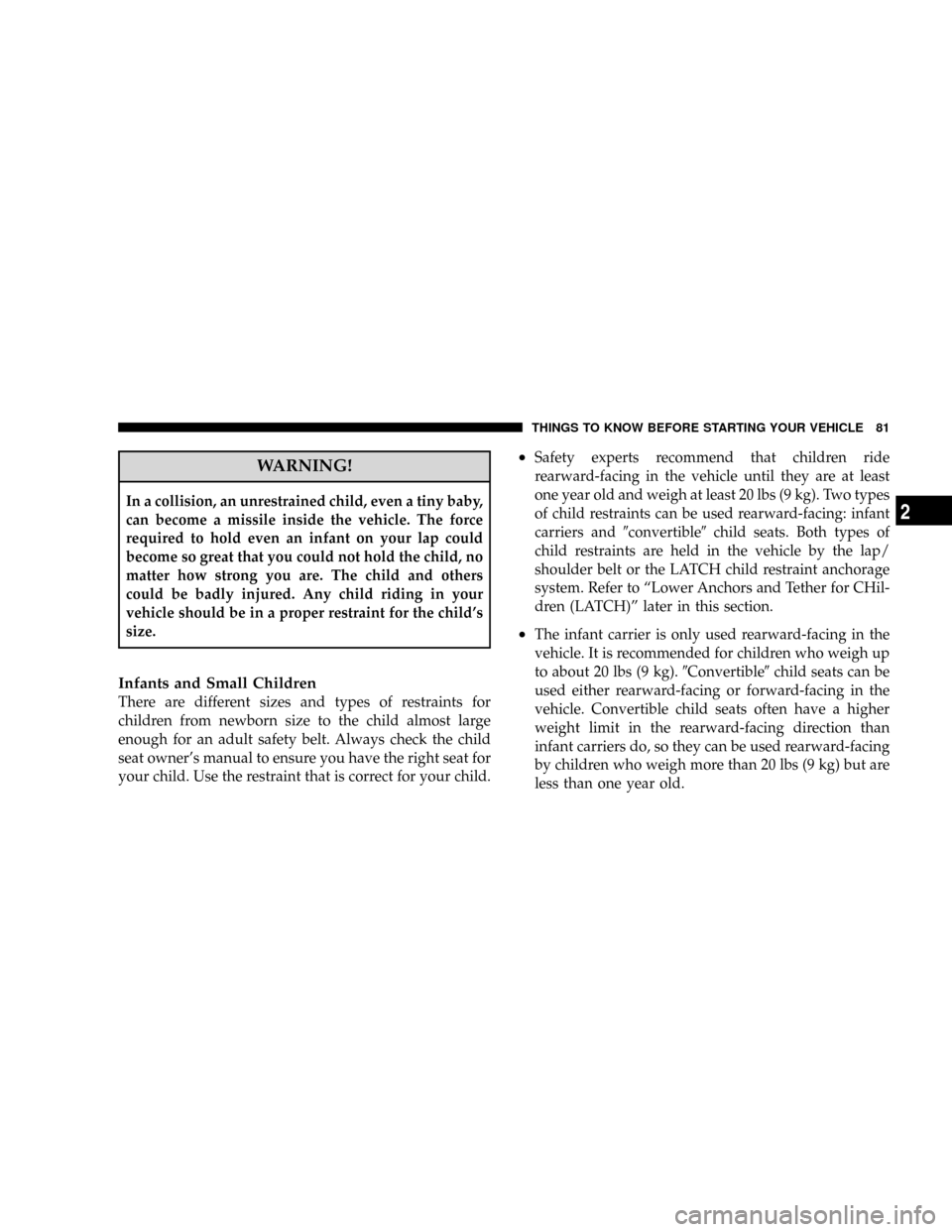
WARNING!
In a collision, an unrestrained child, even a tiny baby,
can become a missile inside the vehicle. The force
required to hold even an infant on your lap could
become so great that you could not hold the child, no
matter how strong you are. The child and others
could be badly injured. Any child riding in your
vehicle should be in a proper restraint for the child's
size.
Infants and Small Children
There are different sizes and types of restraints for
children from newborn size to the child almost large
enough for an adult safety belt. Always check the child
seat owner's manual to ensure you have the right seat for
your child. Use the restraint that is correct for your child.
²Safety experts recommend that children ride
rearward-facing in the vehicle until they are at least
one year old and weigh at least 20 lbs (9 kg). Two types
of child restraints can be used rearward-facing: infant
carriers and9convertible9child seats. Both types of
child restraints are held in the vehicle by the lap/
shoulder belt or the LATCH child restraint anchorage
system. Refer to ªLower Anchors and Tether for CHil-
dren (LATCH)º later in this section.
²The infant carrier is only used rearward-facing in the
vehicle. It is recommended for children who weigh up
to about 20 lbs (9 kg).9Convertible9child seats can be
used either rearward-facing or forward-facing in the
vehicle. Convertible child seats often have a higher
weight limit in the rearward-facing direction than
infant carriers do, so they can be used rearward-facing
by children who weigh more than 20 lbs (9 kg) but are
less than one year old.
THINGS TO KNOW BEFORE STARTING YOUR VEHICLE 81
2
Page 84 of 531
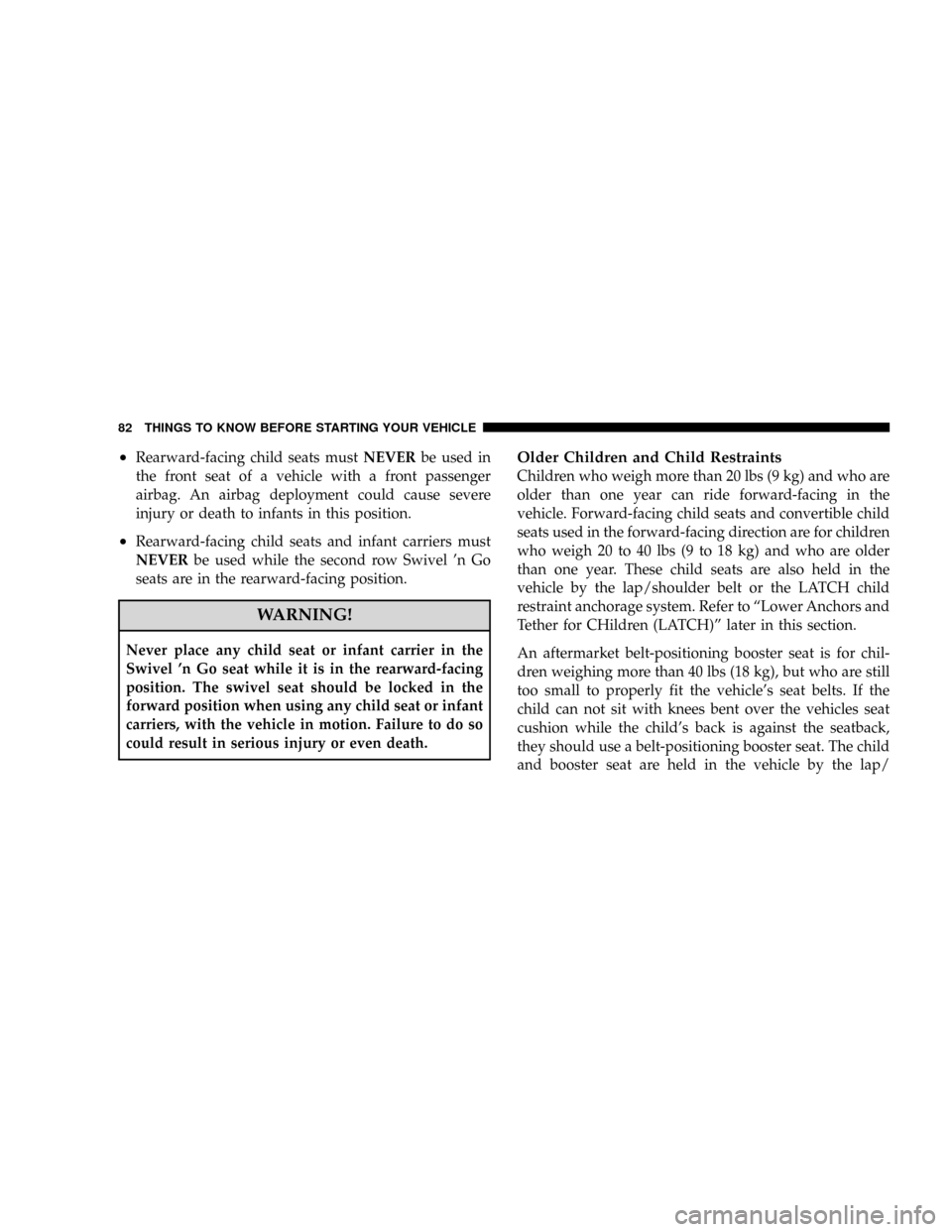
²Rearward-facing child seats mustNEVERbe used in
the front seat of a vehicle with a front passenger
airbag. An airbag deployment could cause severe
injury or death to infants in this position.
²Rearward-facing child seats and infant carriers must
NEVERbe used while the second row Swivel 'n Go
seats are in the rearward-facing position.
WARNING!
Never place any child seat or infant carrier in the
Swivel 'n Go seat while it is in the rearward-facing
position. The swivel seat should be locked in the
forward position when using any child seat or infant
carriers, with the vehicle in motion. Failure to do so
could result in serious injury or even death.
Older Children and Child Restraints
Children who weigh more than 20 lbs (9 kg) and who are
older than one year can ride forward-facing in the
vehicle. Forward-facing child seats and convertible child
seats used in the forward-facing direction are for children
who weigh 20 to 40 lbs (9 to 18 kg) and who are older
than one year. These child seats are also held in the
vehicle by the lap/shoulder belt or the LATCH child
restraint anchorage system. Refer to ªLower Anchors and
Tether for CHildren (LATCH)º later in this section.
An aftermarket belt-positioning booster seat is for chil-
dren weighing more than 40 lbs (18 kg), but who are still
too small to properly fit the vehicle's seat belts. If the
child can not sit with knees bent over the vehicles seat
cushion while the child's back is against the seatback,
they should use a belt-positioning booster seat. The child
and booster seat are held in the vehicle by the lap/
82 THINGS TO KNOW BEFORE STARTING YOUR VEHICLE